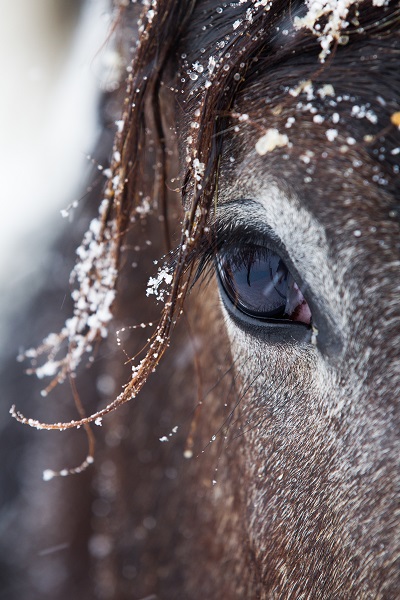Posted: 14th January 2019 | Back to news feed

Winter can sneak up on us when Christmas is around the corner, but in January there’s no doubt that we are now facing the coldest time of year and the short days, frost, mud, rain, wind, sleet and snow that all conspire to make horse owner’s lives that little bit trickier.

To help owners manage, innovative horse health company Haygain examine the ways our horses adapt to cope during the colder months of the year and highlight the products that will ensure equines stay comfortable until the spring grass and warmer days arrive.
Evolution – how horses managed without us
Horses have evolved to cope well with the cold weather and poor foraging conditions of a northern hemisphere winter. They will demonstrate reduced movement and their metabolic rate slows down as winter arrives – indeed, research has even shown that horses’ heart rates slow during the ‘low light’ season. Their bodies ignore some of the appetite regulating hormones during the summer which means they can put on weight when there is an abundance of food, and in autumn those hormones once again take effect to prepare horses for the search for food in winter.
Horses have a low thermo-neutral zone which means that they can cope easily with far lower temperatures (0 to -2°C) than humans can without requiring any additional energy to maintain their bodyweight. Left to their own devices, horses will grow an impressive winter coat (even ‘thin-skinned’ breeds such as Arabs) and forage fermentation in the equid hindgut acts like a personal central heating system.
The behaviour of the managed horse in winter
In order to ride horses in winter, whether for competition or as a hobby, we often manage their lifestyle in a manner which impacts their natural evolutionary reaction to winter. Thanks to the slowing of their metabolism, horses may be more lethargic and less willing to exercise. Take extra time to warm up prior to medium or hard work and consider reducing work if it isn’t necessary.
Living outside with a warm winter coat…
We might sit indoors and look out at a cold, frosty morning and think how appealing a stable with a deep, warm bed must be, but a Swedish study showed that horses always prefer to live outside, seeking shelter only in the heaviest rain and strongest wind. Most horses don’t need rugs or stables to manage in the winter and will grow an amazing natural coat when the season starts to change, complete with a waterproof top layer and snug undercoat. If your horse isn’t in strenuous work, why not leave them with their full winter coat and living outside? Their heels and neck will be better protected against mud fever and rain scald, and they will be perfectly able to regulate their own temperature as the weather changes. You must of course check them regularly and ensure they have access to shelter from rain, plenty of forage and fresh water.
Feeding the horse in winter
Forage alone can provide enough energy for most horses through the winter. As previously mentioned, horses are designed to put on weight when there is plenty to forage on in warmer times, preparing them for when food can be scarce. That means you might find your horse is carrying some extra weight in the Autumn and doesn’t need hard feed at all. If you need to reduce forage feed to manage weight, but want to ensure your horse is still able to ‘graze’ whilst stabled (no horse should fast for more than 4 hours), why not consider the Haygain Forager Slow Feeder? It imitates the natural grazing behaviour of a horse and slows their eating right down, perfect to keep them occupied for long winter nights in the stable. You could also offer edible straw bedding as an alternative to higher quality (and cost) hay – just ensure you introduce any changes slowly.
Water
Horses will drink less when the temperature of their water drops below 7°C and if you look after an older horse with sensitive or damaged teeth, they may be reticent to drink chilly water at all. The risk of colic increases with dehydration, so if drinkers or troughs become too cold try offering warmer bucket water as well. Steamed hay could be an excellent solution for those who won’t drink as it contains more moisture than dry forage, helping to hydrate horses while they eat. The Haygain Steamer is incredibly easy-to-use and comes in a range of sizes depending on how many horses you need to steam hay for. There are multiple other benefits to steaming hay that will support your horse’s overall health, such as greatly reducing the levels of particles that cause respiratory disorders, eliminating virtually all moulds and spores and making the hay far more palatable.
Find out more about the Haygain range
Visit www.haygain.co.uk to browse the full range of products and find out how Haygain can help keep your horse healthy and happy during the long, dark winter.
The Equestrian Index newsfeed is compiled from articles submitted by advertising members and expresses the opinions of those members. Watsons Directories Ltd shall not be held liable for any inaccuracies or mis-statements therein.